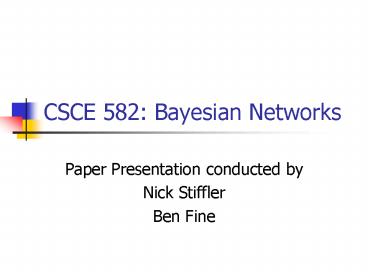CSCE 582: Bayesian Networks - PowerPoint PPT Presentation
Title:
CSCE 582: Bayesian Networks
Description:
CSCE 582: Bayesian Networks Paper Presentation conducted by Nick Stiffler Ben Fine Bayesian networks: A teacher s view Russel G Almond Valerie J Shute Jody S ... – PowerPoint PPT presentation
Number of Views:124
Avg rating:3.0/5.0
Title: CSCE 582: Bayesian Networks
1
CSCE 582 Bayesian Networks
- Paper Presentation conducted by
- Nick Stiffler
- Ben Fine
2
Bayesian networks A teachers view
- Russel G Almond
- Valerie J Shute
- Jody S. Underwood
- Juan-Diego Zapata-Rivera
3
ACED
- A Computer-Based-Assessment-for-Learning system
covering the topic of sequences - In this Paper it spans three sequence types
- Arithmetic
- Geometric
- Recursive
4
ACED
- A Prototype that explores
- Madigan and Almond Algorithms for selection of
the next task in an assessment - The use of targeted diagnostic feedback
- Tech solutions to make the assessment accessible
to students with visual impairments
5
Geometric Sequence Model
- Proficiency Levels available to each node
- Low .
- Medium
- High .
6
Bayesian Network (SS)
- Individual task outcome variables
- -are entered as findings in task specific
nodes where the results are propagated through
the proficiency model - Posterior Proficiency Model
- -gives the belief about the proficiency state
for a particular student - Note Any functional of the posterior
distribution can be - used as a sore
7
Terminology
- Si0, Si1,,Sik proficiency variables for
student i - Si0 special overall PV (Solve Geo.
Problems) - Xi Body of evidence
- P(SikXi)
- -conditional distribution of Sk given the
observed outcomes
8
The Four Statistics (at least the ones we look
at)
- Margin
- Cut
- Mode
- EAP
9
Margin
- The Marginal Distribution of Proficiency
- P(SikXi)
- expected numbers of students in each proficiency
- Si P(SikXi)
- Average proficiency for the class
- Si P(SikXi)
- class size
10
Cut
- Identifier for a special state
- Ex. students medium are proficient
- P(Sik medium Xi)
- Average cut score is the expected proportion of
proficient students in the class
11
Mode
- The value of m the produces
- maxP(Sik m Xi)
- Improvements
- If student is within a threshold should be
identified as being on the boundary - When the Marginal Distribution is evenly spread
out the system should identify students who have
the greatest uncertainty - To get modal scores count the number of students
assigned to each category
12
EAPExpected a Posteriori
- Assign numbers to states to get an expectation
over posterior - High 1
- Medium 0
- Low -1
1P(Sik high Xi) 0 P(Sik med Xi)
-1P(Sik lowXi) Reduces to
P(Sik high Xi) - P(Sik low Xi)
13
EAP (cont.)
- What it means
- The EAP would return the average ability level
for each class - Standard Deviation variability of proficiency
14
Scores coming out of the BN
15
Individual Level Plots
16
Comparing Groups
17
(No Transcript)
18
Comparing Groups
19
(No Transcript)
20
Reliability
- Observed Score True Score Error
- Signal to noise ration in signal processing
- Applying the Spearmen Brown formula
21
Spearmen Brown formula
is the predicted reliability
N is the number of "tests" combined
is the reliability of the current "test"
predicts the reliability of a new test by
replicating the current test N times creating a
test with N parallel forms of the current exam.
Thus N 2 implies doubling the exam length by
adding items with the same properties as those
in the current exam.
22
Why BN Works Well
- Offers significant improvement over number right
scoring - Bayes network estimates stabilize sub scores by
borrowing strength from the overall reliability - Differs from other methods b/c it starts with an
expert constructed model of how the proficiencies
interact - Other methods use observed correlations b/t the
scores on subtest























![CSCE 580 Artificial Intelligence Introduction and Ch.1 [P] PowerPoint PPT Presentation](https://s3.amazonaws.com/images.powershow.com/6301291.th0.jpg?_=20201003053)







